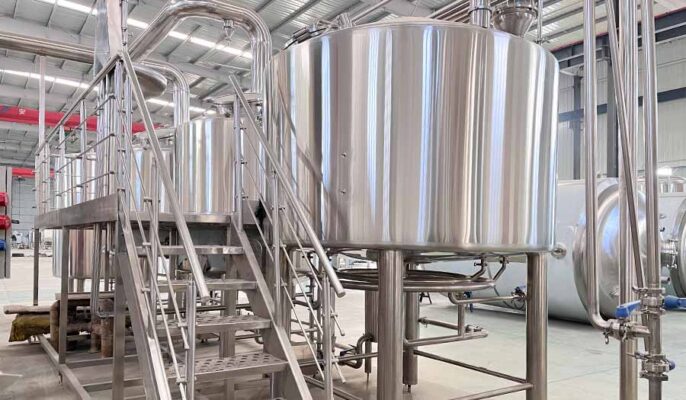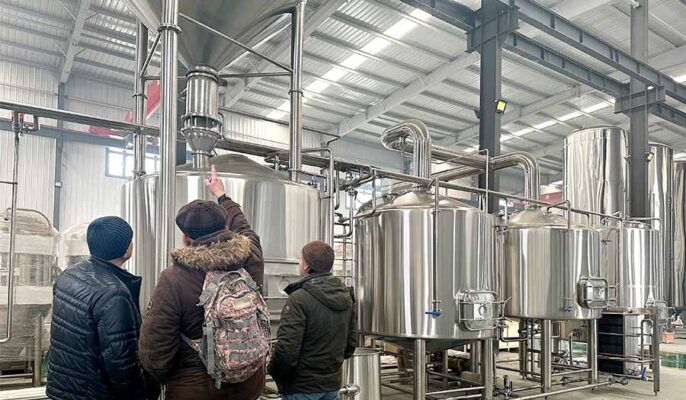There are more and more automation options on the market today to please your cravings. Automated brewing systems are advanced solutions designed to simplify and optimize the brewing process. As much as we love brewing beer, we understand that not everyone is eager to uncover every detail of the brewing process. The key is using automated systems to produce quality beer. Automatic beer brewing machines are faster and more convenient than traditional beer brewing methods.
What automated brewing system?
Automatic brewing systems are innovative devices designed to simplify the brewing process for home brewers and commercial brewers alike. These systems leverage advanced technology to automate every stage of brewing, from mashing to fermentation and even bottling. With the push of a button, beer lovers can now brew their favorite beers without a lot of manual labor.
Basic components of automated brewing equipment
- Control panel: This is the brain of the operation. Through the touchscreen interface, brewers can adjust settings, control fermentation temperature, and more.
- Automatic mashing: Instead of adding grains, the system does it for you. This ensures consistency from batch to batch.
- Temperature control: Precise temperature control is crucial for brewing. Automated systems provide precise temperature regulation throughout the process.

Introduction to automated brewing equipment
We take 4 vessel brewhouse equipment as an example to introduce automated brewing equipment in an all-round way. 4 vessels include saccharification tanks, filter tanks, kettle tanks, and whirlpool tanks. Each processing unit has an independent pump/valve station, complete internal pipelines, pneumatic butterfly valves, regulating valves, temperature sensors, flow sensors, liquid level sensors, and other measurement and control hardware. It uses Siemens software programming control system PLC to achieve continuous automation. Brew.
Malt grinding
For small systems, a pair of drum pulverizers are often used. The water outlet is connected to the material and water mixer. The start and stop buttons of the pulverizer are used as program start signals. The temperature and flow rate of the water are preset with the opening of the regulating valve of the mash tank and the hot water pump. The speed is controlled by PLC. After mixing, the mixture is pumped from the bottom of the mash tank by a mash pump. After the milling process is completed, the system will run the CIP flush program when the milling machine is shut down. Of course, for large brewery equipment, it is recommended to use a wet malt grinder with a grain tank weighing machine.
Mash tun
All steps can be preset in advance, such as temperature, stirring speed, etc. When the pumping mash process is about to end, the system will add water and discharge the remaining mash liquid. When the material is drained, the pump valve will be stopped and the CIP program will be run. The final interface prompts that the mash process is completed and the next batch of mash liquid can be fed. You can edit the mash formula according to the different requirements of different beer varieties for the mash process. Click the formula according to your needs during production, and the temperature control parameters will be loaded.
Lauer Tank
All process parameters such as tank bottom water, feed, standing, reflux, and filtration are set in advance according to process requirements. The filter tank is ready for water use before the mash tank is discharged and is waiting for feeding. All paving and flushing water is added through flow settings, and the flow is adjusted according to the liquid level to complete filtration in the shortest time. During this time, the speed and height of the rake are controlled by a turbidity sensor. After filtration, the pump valve closes and begins to discharge the grain, and then runs the CIP program.
Kettle water tank
It adopts the form of an internal heater to heat the wort and form strong convection. It is equipped with a diversion cap to form an umbrella-shaped spray surface and improve the volatilization of DMS. The boiling tank operates according to the wort liquid level. After discharging, it stops the pump valve and runs the CIP program.
Whirlpool tank and wort cooling
Set the feed static time and wort pipeline, sterilization parameter settings, wort cooling parameter settings, linkage control with the boiling tank, and other parameters in advance. Set the feed end time to the automatic start time. 30 minutes before the end of the static period, the high-temperature Sterilization starts . The program starts high-temperature sterilization, starting from the wort cooling plate to the wort inlet pipe of the fermentation tank and returning to the hot water tank. The wort enters fermentation through automatic temperature control through the cooling plate.
Cold water tank and ice water tank
Liquid-level real-time display and control. The cold water tank is used to cool the mashed wort. The brewing water is frozen to 4°C. After heat exchange with the wort, it reaches 80°C. It then enters the hot water tank for feeding and washing. When the ice water tank is used for fermentation, the refrigerant is ethanol. Diol temperature is usually maintained at -4°C. When wort cooling and fermentation cooling are working, the ice water pump will be started by the program.
Fermenter
The temperature of the fermenter is controlled in two stages. Once the wort enters the tanks, you can set individual temperature profiles for each tank. After the setting is completed, click Run and the system will control the temperature and pressure according to the set values.
When encountering a critical node, you will be reminded to take samples or wait for confirmation to avoid quality problems. The fermentation tank’s compressed air, carbon dioxide, wine inlet pipe, wine outlet pipe, and CIP water supply and return can all be set . After the setup is complete, form the tube row and connect it to the fermenter with jumpers. When each tank operates , it will not affect the work of other tanks.

Application types of automated brewing equipment
- As demand grows and technology evolves, manufacturers introduce many types of systems to meet different brewery sizes and needs.
- Small brewery systems: These systems are designed for small-scale production and have a capacity of 50 to 500 liters. They’re perfect for craft brewers who value quality over quantity. Although smaller, it still offers powerful automation capabilities.
- Pub brewery system: Designed for bars or restaurants that brew beer on-site. They balance small-scale craft production with the need to provide larger volumes to direct customers.
- Industrial brewery systems: used for large-scale production with capacities exceeding 10,000 liters. Major beer brands and large breweries use these systems. They are designed for efficiency and high-volume production.
- R&D brewery system: The R&D system is used for experimental batches. Breweries use them to test new recipes, ingredients, or brewing methods without committing to large-scale production.
- Mobile Brewing Systems: New to the market, these systems are mounted on trailers or trucks, allowing brewers to move their operations for events, collaborations, or special occasions.
Advantages of automated brewing equipment
- Efficiency improvements: One of the main advantages of automated brewing systems is efficiency. By automating many manual aspects of the brewing process, these systems can produce more beer in less time, optimize production schedules, and increase the quantity of sellable products.
- Consistent quality: In the brewing industry, consistency is critical. Fans of a particular beer brand expect the same taste, aroma, and mouthfeel every time they open the bottle. The automated system ensures that the quality of each batch matches the previous one through precise control of ingredients, temperature, and time.
- Save resources: Through precise measurement and control, automated systems can save raw materials, energy, and water. This not only reduces costs but also minimizes waste, making the brewing process more sustainable.
- Real-time data monitoring: Modern commercial automated brewing systems are equipped with a variety of sensors and analysis tools. These tools provide brewers with real-time data about the brewing process, allowing them to make informed decisions and resolve any issues that may arise.
- Scalability: As a brewery grows, its production needs will change. Automated systems can be scaled up (or down) to meet production needs. Whether adding more fermenters or integrating extra features, these systems can grow as your business grows.
- Labor savings: By automating many tasks that were before done , breweries can operate with fewer employees. This can result in significant savings in labor costs. Besides, employees can be reassigned to other areas of the business, such as sales, marketing, or customer service.
- Enhanced safety: Brewing involves handling hot liquids, heavy equipment, and sometimes the cleaning and sanitizing of hazardous chemicals. Automated systems can reduce the risks associated with these tasks and ensure a safer working environment.
Where can I buy automated brewing equipment?
- Trade Shows and Exhibitions These events provide potential buyers with unique opportunities to see equipment in person, interact with manufacturers, and sometimes even witness live demonstrations.
- Many brewing system manufacturers also have websites showcasing their products, features, and technical specifications. Websites often have contact forms that enable potential buyers to ask specific questions or request a quote.
- Visits to production facilities are valuable for those willing to go. It provides an on-the-ground view of production processes, quality assurance measures, and the opportunity to interact with the team.
- Depending on the region, there may be local distributors or distributors that specialize in brewing equipment. Micet partners with global manufacturers to ensure products are authentic and of high quality. micet provides customized services and professional technical support.




